
Too Perfect
June 20th, 2013

1680x1050 wallpaper
It looked like it belonged in someone's garden. But it was at Carp Ridge, blazing up out of the shady undergrowth amidst columbine and corydalis. Mike noticed it first. My flowers guide pegged it as a Wood Lily: a true Ontario wildflower, unlike the orange day-lilies that sometimes escape cultivation.
Fledgling Season
June 18th, 2013
At least for some birds, their young are out of the nest. Sometimes a young bird will leave the nest before it can fly, either by accident or on purpose (to escape nest parasites.) In such a situation, the parents get very nervous when large mammals (i.e. us) come lumbering by, and some will engage in what's called "distraction display" to try to lure us away from their vulnerable young. This is probably why those two towhees were so easily photographed! ("Easily" being a relative word, mind you. It still took a half hour's work to get unobstructed close-ups.)
I got a rather transparent distraction display this afternoon from a Winter Wren, one of the many breeding birds at South March Conservation Forest. As I approached, the normally furtive, mouselike adult wren twittered nonstop while perched in plain view. Its young, perhaps unwisely, got curious and hopped up on a log to look at me. It still had the colorful gape flanges of a nestling bird, so it probably couldn't fly yet, which explains its parent's dismay!
The adult continued to make a huge racket, so I followed it on down the trail. It led me down the proverbial garden path a bit, until it felt that I was far enough away, and then it clammed up and flew back to its young. The whole thing was very charming and definitely the high point of my hike.
Native Wildflowers Of Carp Ridge
June 15th, 2013
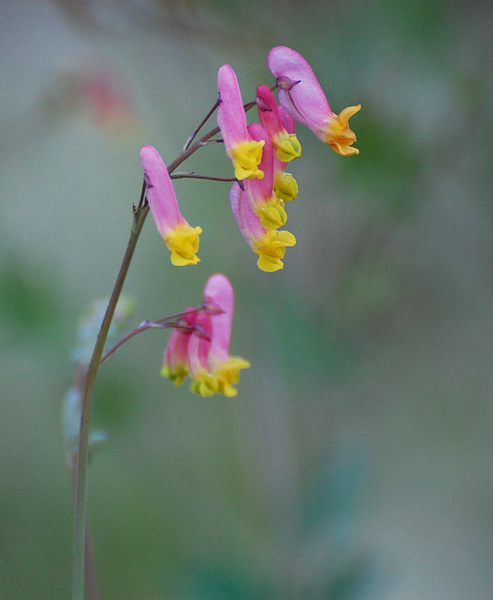
Pale Corydalis. The rugged, moss-encrusted rocks of the Carp Ridge barrens seem to be the perfect habitat for this wildflower. It grows there in generous sprays. It's the kind of "weedy" flower that is easily overlooked, but up close, quite beautiful.
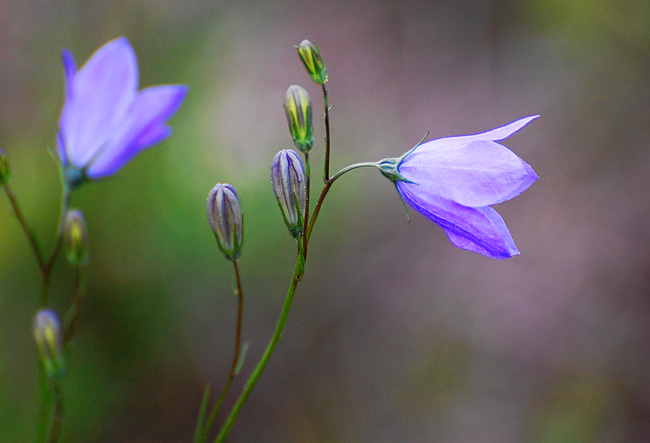
1680x1050 wallpaper
Harebells are a true Ontario wildflower, unlike the more common (invasive) Creeping Bellflower that they resemble. I find them more charming than bellflower, but then, maybe I'm just biased towards the natives!
Two Ottawa firsts, one welcome, one not
June 13th, 2013
I went exploring the Carp Ridge barrens off Thomas Dolan yesterday evening. This is a beautiful, open area of rocky ledges carpeted in mosses and wildflowers--no trails, but you don't really need them. There I got an Ottawa first, Eastern Towhee. This unusually handsome sparrow is a common bird in the southern states where I come from, but in Ottawa they are at the limit of their range, and the population is very small and very localized. Carp Ridge is one of the only places to find them.
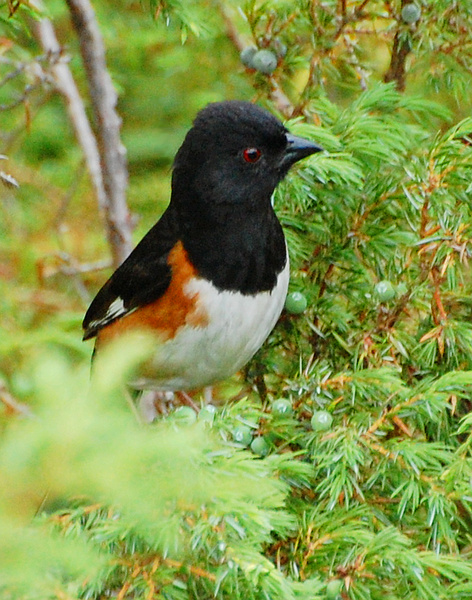
1680x1050 wallpaper
Eastern Towhee is a noisy bird of the undergrowth. It gives itself away not only with its scolding "chewink!" call and its distinctive "drink-your-tea-tea-tea" song, but with the sound of two feet vigorously scratching at the undergrowth. A foraging towhee makes as much noise as a squirrel. At Carp Ridge, they seemed to like foraging in the clumps of juniper bush. I was also happy to capture one standing in the crispy, silvery moss that blankets the rocks there.
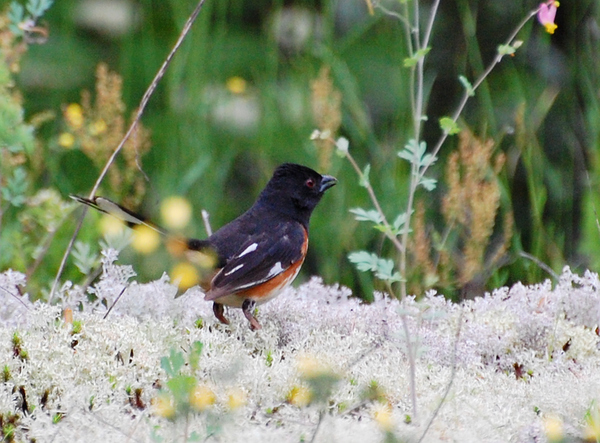
His mate keeping an eye on me:

Unfortunately, I also found a second Ottawa first. A tick. A Blacklegged Tick. Yes, the type of tick that transmits Lyme Disease, and I did not so much find it at Carp Ridge as on my body, dug in and holding on for dear life, about an hour after I got home. I guess it's no surprise. I guess it's no surprise that when it finally happened, it happened at Carp Ridge: that an area known for having birds at the northern limit of their range (whippoorwill, towhee, golden-winged warbler) would also have an insect at or near the northern limit of its range. But I was in denial that such a thing was possible here. No more.
It wasn't on me long enough to transmit disease, but I'll still send it to the authorities for testing.
A Spine-Tingling Night
June 8th, 2013
Since as long as I've been a birder, I've longed to hear the call of whip-poor-wills. They're nocturnal birds, the most well-known of the nightjar family (also colorfully called the goatsuckers.) By day, they sleep on the ground or horizontally perched on tree limbs, and their dead-leaf camouflage make them almost impossible to spot. As dusk sets in, they awake and sing their names over and over.
I grew up with the sound of whip-poor-wills emanating from the woods behind our house, joining the summer chorus of crickets and tree frogs. So naturally Virginia was the first place I though to look for them. But I had no luck. I went deep into those woods (so deep that I probably ended up in Pocahontas State Park!), explored everywhere else I could think of from sunset to dusk, and never heard a one. Whip-poor-wills are on the decline everywhere. In many places they've disappeared, and unfortunately one of those places is my parents' neighborhood.
So I finally decided to put a serious effort into finding them in Ottawa instead, even though our population of whip-poor-wills is tiny and extremely localized. The plus is, here we have a vibrant birder community that can tell me exactly where to find them! So with the guidance of NeilyWorld, I drove to where Huntmar Drive crosses the train tracks, found a place to park, took a flashlight and went exploring.
It was in the woods where it finally happened. I'd been listening for some time to the evensong of veeries and wood thrushes when a distant whip-poor-will joined in. I actually didn't register it at first, and by the time I had it stopped. But ten minutes later another one started up, this one startlingly loud and close!
I spent the next hour or so, to dusk and beyond, trying to actually see one so I could lifelist it, but with no luck. My eager approaches seemed to scare them away, or at least scare them silent. But really, just hearing them is what I was hoping for! And I now understand what Peterson's meant by "tiresomely repeated." It's like they don't even stop to breathe. Although there are the occasional lulls. One long lull was finally punctuated by the spine-tingling sound of a pair of coyotes howling to each other--and then a whip-poor-will immediately started up again, as if he considered that his cue!
I'm happy with Ottawa. It may not have wolves. It may not have lynxes. But so long as it still has coyotes and whip-poor-wills, Ottawa is wild enough to make me happy.
Literally A Puddle Duck
June 4th, 2013
I've been enjoying watching this fellow, a lingering spring migrant, for the last few days. It's a species I seldom see in Ottawa.
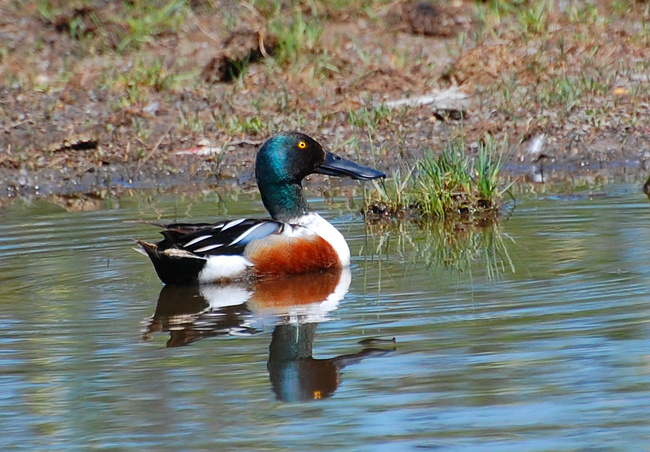

Northern Shovelers are specialist feeders that use their oversize bills to skim food from the water surface. Their bills have comb-like structures called "lamellae" that act as sieves. This one was actually on a melted snow dump along March Valley Road, and the water it was swimming in was no more than a glorified puddle. (Dabbling ducks as a group are sometimes called "puddle ducks", but it's usually not quite this literal.) Strange habitat, but birds often show up in places we don't expect, especially in migration!
It's that time of year
May 29th, 2013
Newborn gosling time!
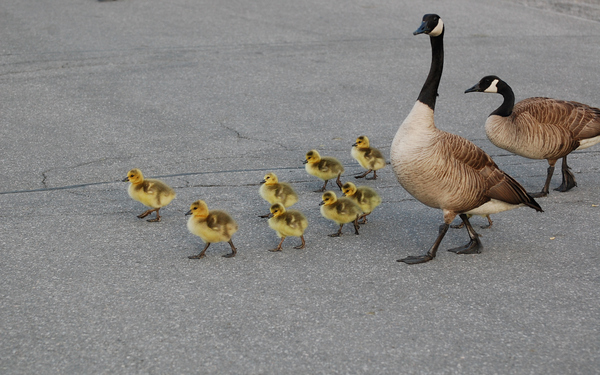
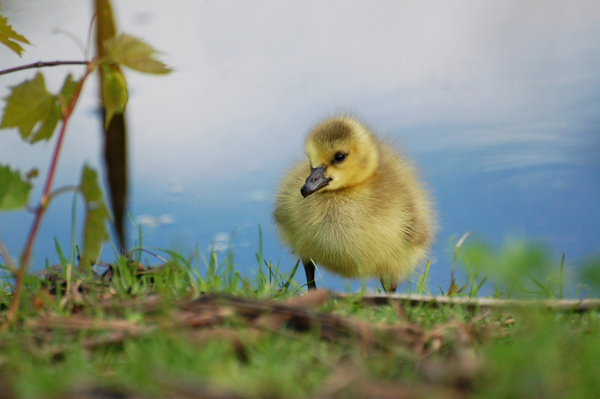
Virginia/Carolina Triplist
May 18th, 2013
Below is the triplist for my spring 2013 visit to Virginia and Cape Hatteras.
( Herein )
The stars of the show, of course, were my three lifers: Lesser Black-Backed Gull, Wilson's Phalarope, and American White Pelican. White Pelicans are uncommon in the east, huge birds with nine-foot wingspans--significantly more impressive than Outer Banks' common Brown Pelicans. This sighting even got mom excited. Unfortunately, it was very far away, so I have no decent photos to share. See here instead!
For Wilson's Phalarope, likewise, I have no good photos, so I refer you to this video of a group of phalaropes doing what they do best: spinning! Phalaropes' unique strategy for catching food is to create a little vortex in the water, drawing small insects and crustaceans up to the surface.
ETA: make that four lifers. I forgot about Yellow-Throated Vireo.
Birds of Hatteras and Dutch Gap
May 14th, 2013
Some non-gallery-worthy but interesting bird photos from Hatteras, plus one from Dutch Gap in Virginia.
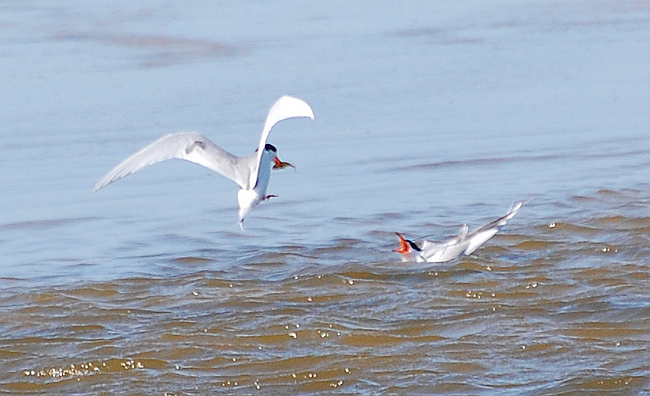
These are Forster's Terns, a very common sight in the Outer Banks, caught at an interesting moment. If it were late summer, and they weren't both in adult plumage, I'd say it was a parent feeding a fledgling. But this time of year it must be courtship. Perhaps it's a sort of role-playing, with the male showing off what a good provider he can be!
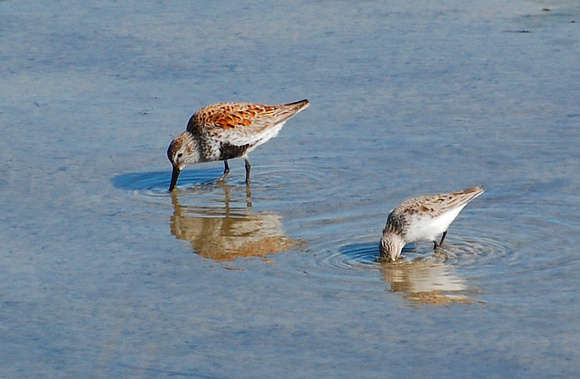
Dunlin (back left) and Semipalmated Sandpiper foraging in close company. Dunlins are common winter-resident sandpipers in the Outer Banks; the Semipalmated is just passing through.
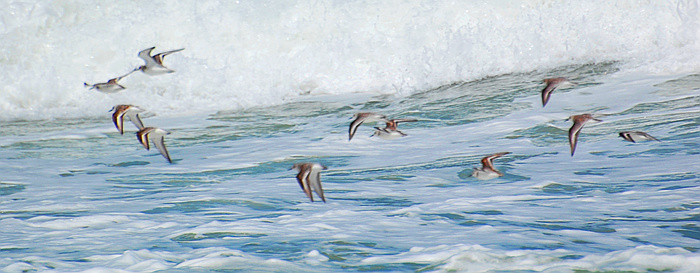
A flock of Sanderlings. These birds can be found in large flocks on seashores in winter and migration, feeding on mole crabs and other denizens of the surf edge.
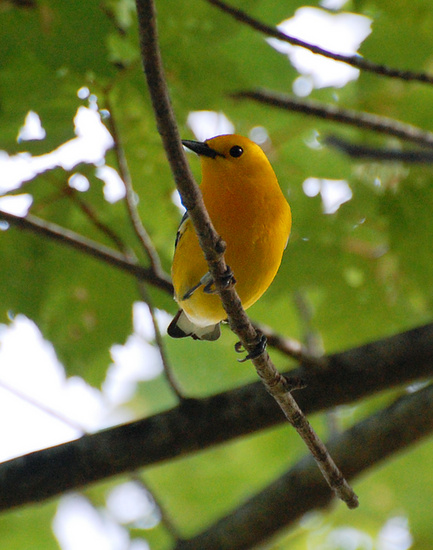
Prothonotary Warbler, a unique swamp-dwelling, hole-nesting, beady-eyed, intensely golden warbler. Alas, we don't have any in Ottawa--we're a little too far north. They are abundant at Dutch Gap. Their natural nest site would be a woodpecker hole in an old dead tree in a swamp, but increasingly they use manmade bird boxes built over water. I'm still waiting to get a photo that truly does justice to this beautiful bird.
Virginia Highlights
May 10th, 2013
A few photos from my visit in Virginia this spring.
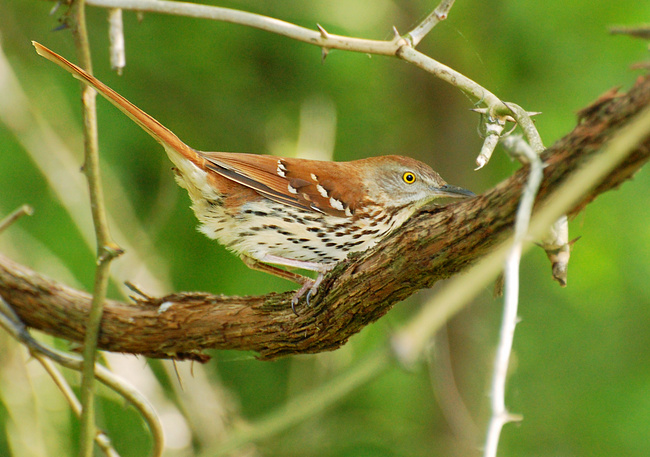
1680x1050 wallpaper
Brown Thrashers are elusive birds, normally. They like to stay hidden in thick bushes and underbrush--except when they rise into treetops to sing. (It's quite a song.) They only do it in spring, and only in the mornings and evenings. And my experience is that if I get too close at these times, they'll think better of it, dive back into the underbrush and continue singing from there.
But in Virginia, there are just so many of them that they seem to boil over the rim of their brushy habitat, spilling out into trails, clearings, and suburban yards. So it's not surprising that Chesterfield is where I finally took my first decent, wallpaperable photo of the species.
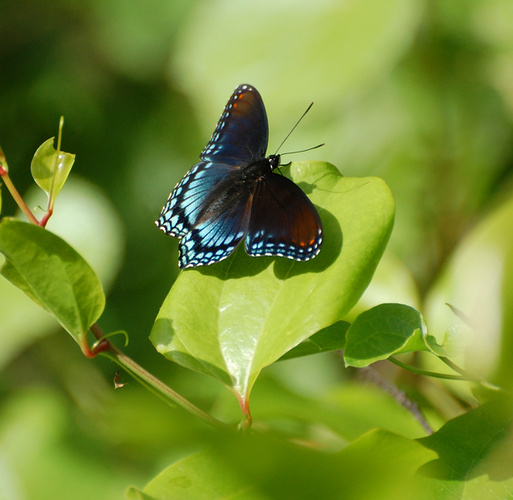
1680x1050 wallpaper
I was quite taken with this blue-winged butterfly I found at Dutch Gap. Turns out it's a subspecies of the plain old White Admiral, which we have in Ottawa. In this form it's called a Red-Spotted Purple, and its coloration mimics the poisonous Pinevine Swallowtail, encouraging predators to leave it alone. Since Pipevine Swallowtail doesn't occur further north (and thus is not familiar to local predators), there's no point in mimicking it here.
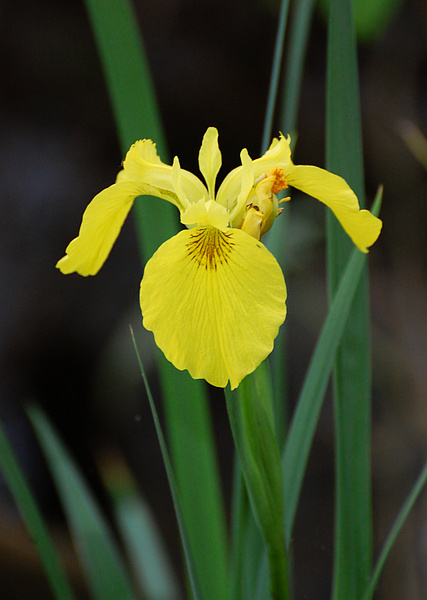
Lovely Yellow Irises were in bloom on the margins of wetlands.
|
